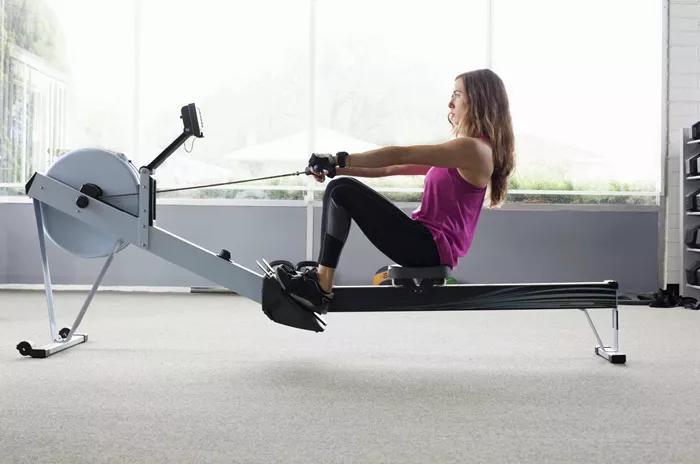Losing weight is a goal shared by many, and one of the most effective ways to achieve it is through consistent exercise. Among the various workout options available, the rowing machine stands out as an exceptional tool for weight loss. Combining cardiovascular exercise with strength training, the rowing machine offers a full-body workout that can help you burn calories, build muscle, and improve overall fitness.
In this comprehensive guide, we’ll explore how to use the rowing machine effectively to lose weight, including the benefits of rowing, proper technique, workout plans, and tips for maximizing your results.
The Benefits of Using a Rowing Machine
Full-Body Workout
One of the primary advantages of using a rowing machine is that it engages multiple muscle groups simultaneously. Each stroke involves your legs, core, back, and arms, providing a comprehensive workout that tones muscles and increases strength.
High-Calorie Burn
Rowing is an intense cardiovascular exercise that can burn a significant number of calories. Depending on your weight and intensity level, you can burn between 400 and 600 calories per hour, making it an effective activity for weight loss.
Low-Impact Exercise
Unlike running or jumping, rowing is a low-impact exercise that is gentle on the joints. This makes it a suitable option for individuals of all fitness levels, including those with joint issues or those recovering from injuries.
Improved Cardiovascular Health
Regular rowing sessions can improve your cardiovascular health by increasing your heart rate, enhancing lung capacity, and promoting better circulation. This can lead to lower blood pressure and a reduced risk of heart disease.
Enhanced Mental Well-Being
Exercise, including rowing, releases endorphins, which can improve mood and reduce stress levels. The rhythmic nature of rowing can also have a meditative effect, helping to clear your mind and enhance mental focus.
Proper Rowing Technique
The Four Phases of the Rowing Stroke
To maximize the benefits of rowing and avoid injury, it’s essential to use proper technique. The rowing stroke consists of four phases: the catch, the drive, the finish, and the recovery.
1. The Catch
Position: Sit with your knees bent and feet secured in the footrests. Lean slightly forward with your arms extended and hands gripping the handle.
Action: Engage your core and prepare to drive back with your legs.
2. The Drive
Position: Push off with your legs, straightening them while keeping your arms extended and back straight.
Action: Once your legs are fully extended, lean back slightly (about 45 degrees) and pull the handle towards your lower chest, keeping your elbows close to your body.
3. The Finish
Position: At the end of the drive, your legs should be straight, back slightly leaned back, and handle pulled into your lower chest.
Action: Hold this position momentarily, engaging your core and back muscles.
4. The Recovery
Position: Extend your arms forward and lean your body forward at the hips.
Action: Bend your knees and slide back to the starting position, ready to begin the next stroke.
Common Mistakes to Avoid
Overreaching: Avoid leaning too far forward or backward. Maintain a slight forward lean at the catch and a slight backward lean at the finish.
Hunching Shoulders: Keep your shoulders relaxed and down, avoiding a hunched posture.
Overusing Arms: Focus on driving with your legs and using your arms to finish the stroke, rather than pulling primarily with your arms.
Creating an Effective Rowing Workout Plan
Warm-Up
Begin each rowing session with a warm-up to prepare your muscles and joints for the workout. A 5-10 minute warm-up at a low intensity can increase blood flow and reduce the risk of injury.
Interval Training
Interval training, which alternates between high-intensity and low-intensity rowing, is an effective way to burn calories and boost metabolism. For example, row at a high intensity for 1 minute, followed by 2 minutes of low-intensity rowing. Repeat this cycle for 20-30 minutes.
Steady-State Rowing
Steady-state rowing involves maintaining a consistent pace and intensity for a set period, such as 30-45 minutes. This type of workout can help build endurance and promote fat burning.
Mixing It Up
To prevent plateaus and keep your workouts interesting, vary your rowing routine. Incorporate different types of workouts, such as interval training, steady-state rowing, and strength-focused rowing sessions.
Cool Down
End each workout with a cool-down period to gradually lower your heart rate and stretch your muscles. Spend 5-10 minutes rowing at a low intensity, followed by stretching exercises to improve flexibility and aid recovery.
Sample Rowing Workouts
Beginner Workout
Warm-Up: 5 minutes of low-intensity rowing
Workout: 3 minutes of rowing at a moderate pace
1 minute of high-intensity rowing
Repeat the cycle 5 times
Cool Down: 5 minutes of low-intensity rowing
Stretching exercises
Intermediate Workout
Warm-Up: 5-10 minutes of low-intensity rowing
Workout: 5 minutes of steady-state rowing at a moderate pace
1 minute of high-intensity rowing
1 minute of low-intensity rowing
Repeat the high-intensity/low-intensity cycle 8-10 times
Cool Down: 5-10 minutes of low-intensity rowing
Stretching exercises
Advanced Workout
Warm-Up: 10 minutes of low-intensity rowing
Workout: 10 minutes of steady-state rowing at a moderate pace
2 minutes of high-intensity rowing
1 minute of low-intensity rowing
Repeat the high-intensity/low-intensity cycle 10-12 times
Cool Down: 10 minutes of low-intensity rowing
Stretching exercises
Diet and Nutrition Tips for Weight Loss
Balanced Diet
Pairing your rowing workouts with a balanced diet is crucial for effective weight loss. Focus on consuming a variety of nutrient-dense foods, including fruits, vegetables, lean proteins, whole grains, and healthy fats.
Portion Control
Even healthy foods can contribute to weight gain if consumed in large quantities. Pay attention to portion sizes and avoid overeating by using smaller plates and bowls.
Hydration
Staying hydrated is essential for overall health and can aid in weight loss. Drink plenty of water throughout the day, especially before, during, and after your rowing workouts.
Meal Timing
Eating regular, balanced meals can help maintain energy levels and prevent overeating. Aim to have a healthy breakfast, lunch, and dinner, with small snacks in between if needed.
Limiting Processed Foods
Minimize the intake of processed and sugary foods, which can contribute to weight gain and have little nutritional value. Instead, opt for whole, unprocessed foods that provide essential nutrients.
Tracking Progress and Staying Motivated
Set Realistic Goals
Setting realistic, achievable goals is key to staying motivated and tracking progress. Break down your weight loss goal into smaller, manageable milestones and celebrate each achievement along the way.
Keep a Workout Journal
Maintain a workout journal to record your rowing sessions, including duration, intensity, and how you felt during and after the workout. This can help you track your progress and identify areas for improvement.
Monitor Your Diet
Keeping a food diary can help you stay accountable to your nutrition goals. Track what you eat and drink each day, noting portion sizes and any changes in how you feel.
Find a Workout Buddy
Having a workout buddy can provide support, encouragement, and accountability. Consider rowing with a friend or joining a rowing class to stay motivated and make your workouts more enjoyable.
Reward Yourself
Rewarding yourself for reaching milestones can help maintain motivation. Choose non-food rewards, such as a new workout outfit, a relaxing massage, or a fun outing.
Conclusion
The rowing machine is a powerful tool for weight loss, offering a full-body workout that burns calories, builds muscle, and improves cardiovascular health. By using proper technique, incorporating a variety of workouts, and maintaining a balanced diet, you can effectively lose weight and achieve your fitness goals. Remember to set realistic goals, track your progress, and stay motivated by celebrating your achievements along the way. With consistency and dedication, the rowing machine can help you transform your body and enhance your overall well-being.
[inline_related_posts title=”You Might Be Interested In” title_align=”left” style=”list” number=”6″ align=”none” ids=”9011,9008,8928″ by=”categories” orderby=”rand” order=”DESC” hide_thumb=”no” thumb_right=”no” views=”no” date=”yes” grid_columns=”2″ post_type=”” tax=””]































